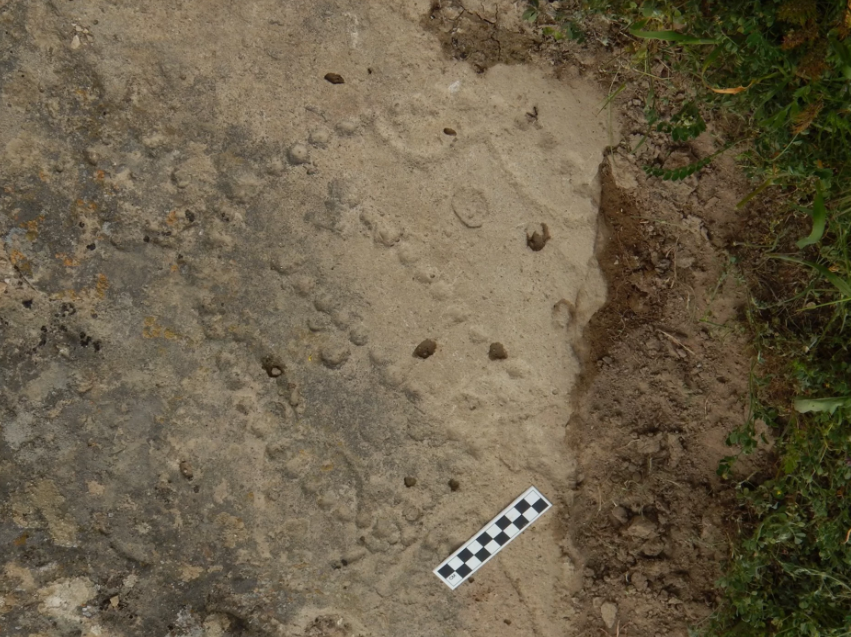Computers, tablets and smartphones have made daily activities and leisure so simple that with one click of a mouse or a tap of the finger, we can join millions of people from around the world in playing online games, like League of Legends, Second Life or chess. Our human ancestors may not have been so fortunate as to be connected in real time, but we know they did have a bit of fun. A recent discovery in Azerbaijan has helped archeologists understand how those that were nomads and hunters spent their down time.
Unusual holes found in the floor of an ancient rock shelter in Gobustan National Park, located in eastern Azerbaijan just southwest of the capital, Baku, were recently examined by Walter Crist, a research associate with the American Museum of Natural History in New York, who has theorized what they are and why the inhabitants of Gobustan carved them.
According to a report published by Live Science earlier this week, Crist said he looked for traces of an ancient board game nicknamed “58 Holes” during a trip he made last year to Gobustan. The findings led him to believe that ancient nomadic herders that were living in Azerbaijan had played one of the world's oldest board games, dating to around 4,000 years ago. By comparison, the game is thought to be something similar to "Snakes and Ladders" played by children in the U.K. and "Chutes and Ladders" in the United States.

Some of the earliest known examples of 58 Holes, which is also known as "Hounds and Jackals" were found by British archaeologist Howard Carter in the tomb of the ancient Egyptian Pharaoh Amenemhat IV, who lived in the 18th century B.C.
Crist said the distinctive pattern of round pits found in Azerbaijan has the same style as what has been discovered in Egypt. But Crist believes that the findings in Azerbaijan could be older than those found in Egypt.
"It suddenly appears everywhere at the same time," Crist told Live Science. "Right now, the oldest one is from Egypt, but it's not by very much. So, it could just be because we haven't found it from somewhere else older. So, [the game] seems to [have] spread really quickly."
Crist journeyed to the Caspian country to deliberately looking for the relics of another 58 Holes game that was played in a much wider area, stretching from Egypt to modern-day Turkey (ancient Anatolia) and modern-day Iraq (Mesopotamia). His investigation in Gobustan National Park – a UNESCO-protected Rock Art Cultural Landscape – suggests that herders in Azerbaijan played a game a similar to modern backgammon, using seeds or stones as dice, to move around the board.
Crist said that any evidence of modern dice has not been found so far in 58 Holes games discovered across the world and backgammon is thought to have its origins in a Roman game called Tabula. But that has not stopped researchers like Crist from digging deeper into the mystery of ancient games.
"It is two rows in the middle and holes that arch around outside, and it's always the fifth, 10th, 15th and 20th holes that are marked in some way. And the hole on the top is a little bit larger than the other ones, and that's usually what people think of as the goal or the endpoint of the game."
Gobustan Rock Art Cultural Landscape is a big plateau of rocky boulders southwest to Azerbaijan’s capital Baku. The site preserves a unique collection of more than 6,000 rock engravings with the oldest rooting back to 40,000 years ago. There one can find remains of once-inhabited caves, settlements and ancient burials, all proving intensive human use by the inhabitants of the area during the wet period that followed the last Ice Age, from the Upper Paleolithic, or from 50,000-10,000 years ago, to the Middle Ages.
The finding in Gobustan suggests that the inhabitants in the region had links to the civilizations in Egypt and the Near East, where board games were very popular in several variants.
Azerbaijan is not the only country in the Caspian region where the game of 58 holes has been found. Necropolis B at Tepe Sialk in Iran contained a game that required two players to throw sticks, stones, seeds or knucklebones to determine the number of holes through which they are allowed to move.







 Iran's senior military leaders described the drone and missile attack on Israel on April 14 night as “successful".
Iran's senior military leaders described the drone and missile attack on Israel on April 14 night as “successful".
 The number of evacuees from flooded areas in Kazakhstan has reached 97,852 people, including about 32,856 children since March 27.
The number of evacuees from flooded areas in Kazakhstan has reached 97,852 people, including about 32,856 children since March 27.
 Azerbaijan officially unveiled the logo for the upcoming 29th session of the Conference of the Parties to the United Nations Framework Convention o...
Azerbaijan officially unveiled the logo for the upcoming 29th session of the Conference of the Parties to the United Nations Framework Convention o...



